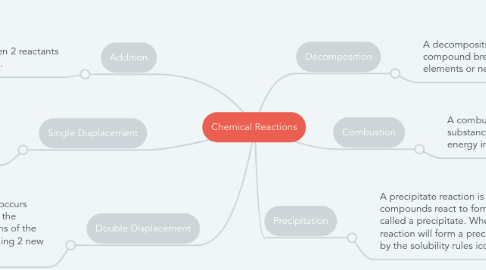Chemical Reactions
von Lauren Jensen


1. Addition
1.1. A combination reaction is when 2 reactants combine to form one product.
1.1.1. Example: Hydrogen (H) & Oxygen (O) combine to make H2O.
2. Single Displacement
2.1. A single-displacement reaction is when an element reacts with a compound and takes the place of another element in that compound.
2.1.1. Example: When Zinc reacts with hydrochloric acid, it makes zinc, chloride and hydrogen.
3. Double Displacement
3.1. A double displacement reaction occurs when two compounds react, and the positive ions and the negative ions of the two reactants switch places, forming 2 new compounds or products.
3.1.1. Example: This happens when silver nitrate reacts with sodium chloride to form sodium nitrate and silver chloride.
4. Precipitation
4.1. A precipitate reaction is when aqueous compounds react to form an insoluble solid called a precipitate. Whether or not a reaction will form a precipitate is dictated by the solubility rules iconic compounds.
4.1.1. Example: An example is when sodium hydroxide reacts with magnesium chloride to produce sodium chloride and magnesium hydroxide.
5. Combustion
5.1. A combustion reaction occurs when a substance reacts with oxygen, releasing energy in the form of heat and light.
5.1.1. Example: When wood reacts with air. It can combust!
6. Decomposition
6.1. A decomposition reaction is when a single compound breaks down into two or more elements or new compounds.
6.1.1. Example: This happens when you open a can of soda and some of the carbon dioxide fizzes out.
